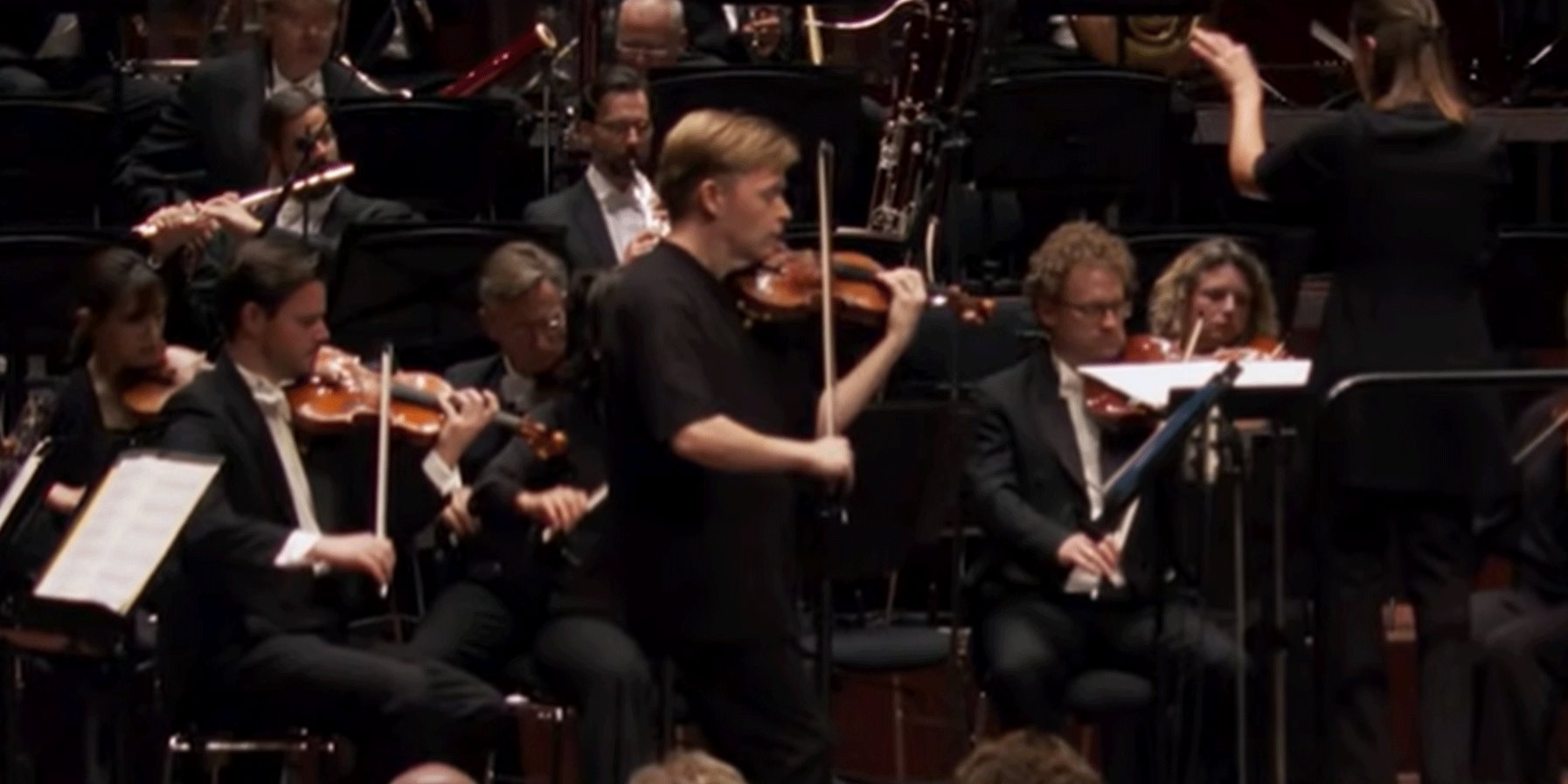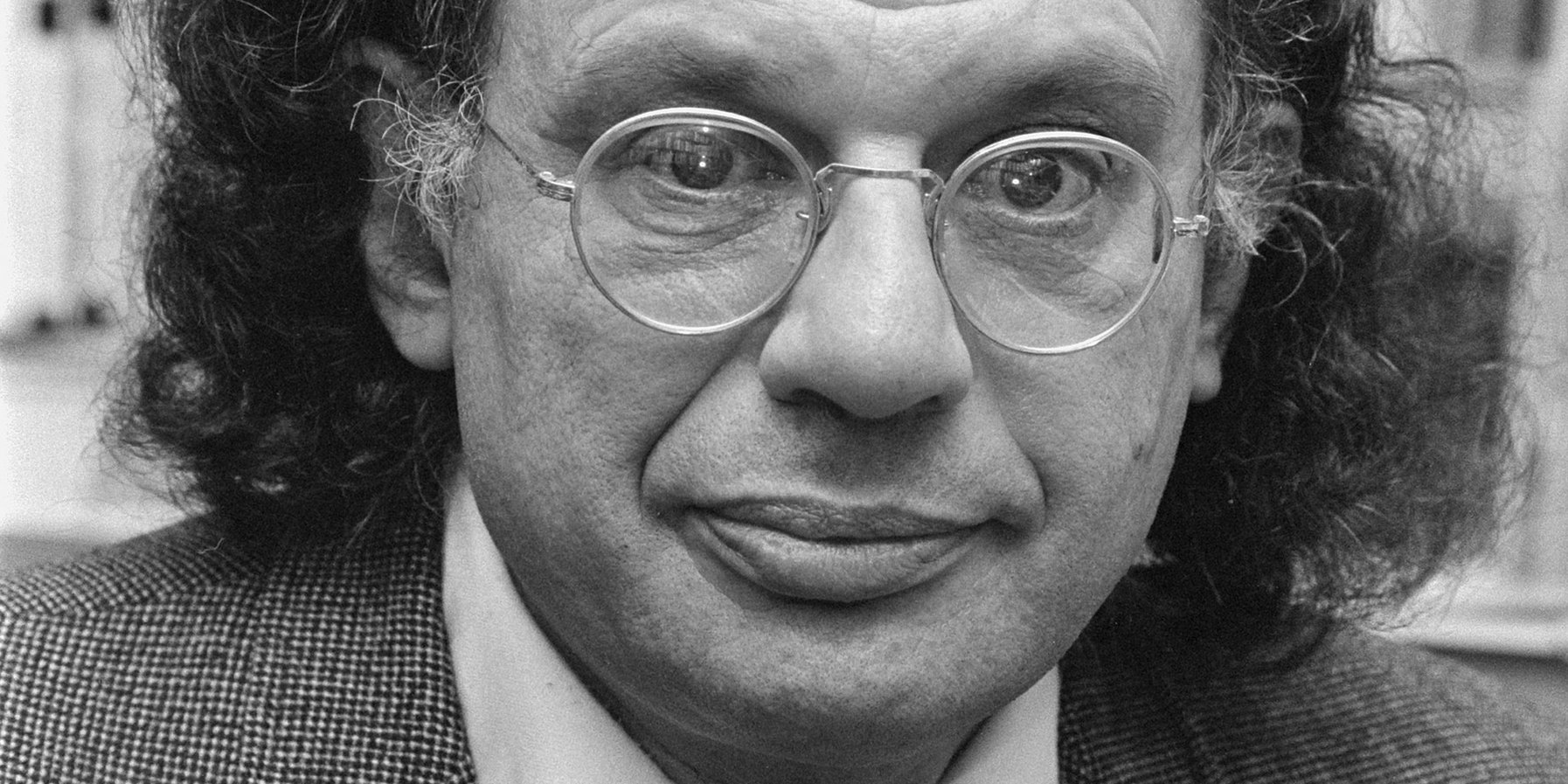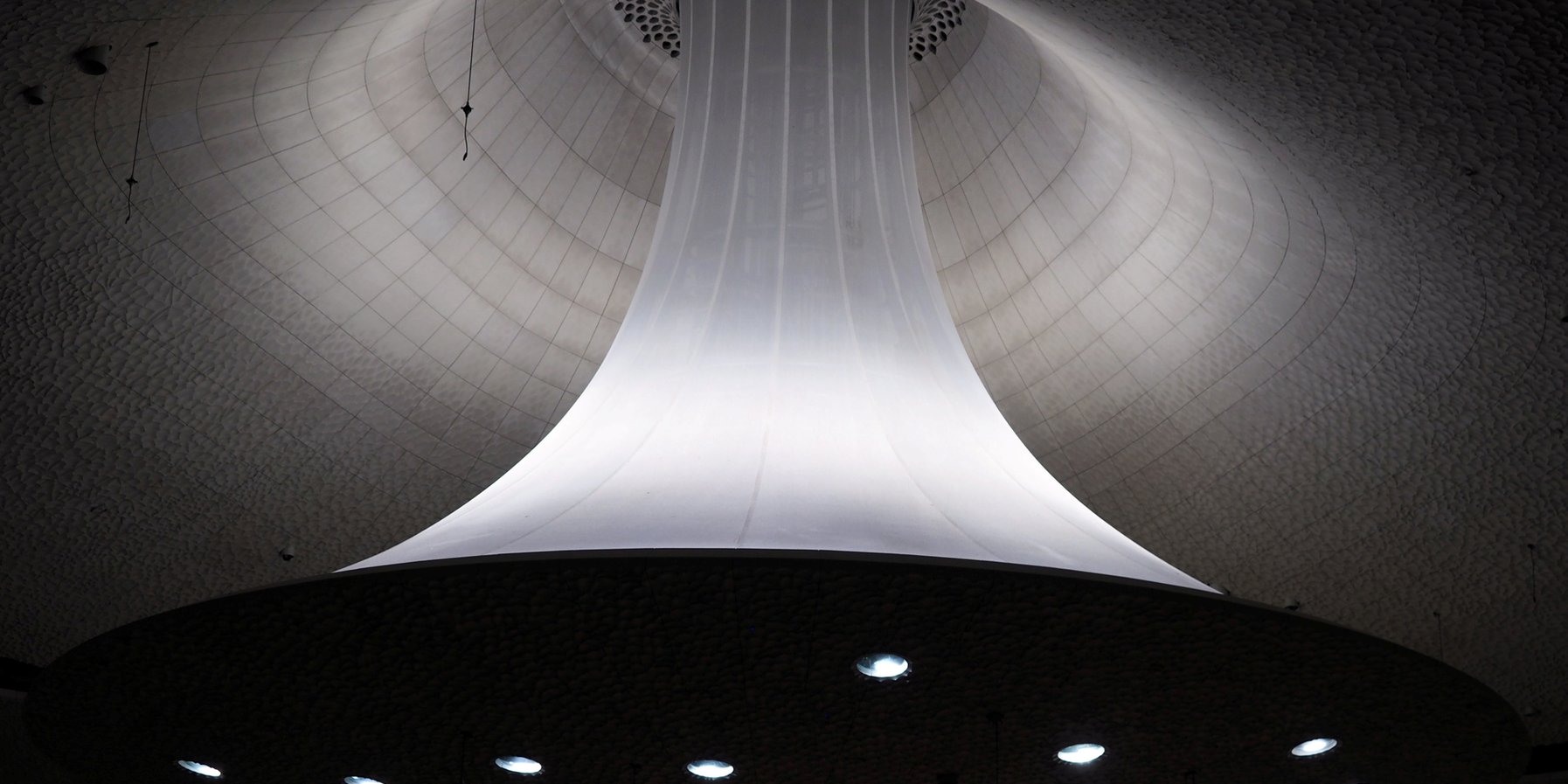Interview: Ivana Rajič
For Bryce Dessner, music is a project without boundaries. He is not only the guitarist with the legendary rock band The National, he also composes classical works for orchestra and writes film music, for example for the Oscar-winning Western thriller »The Revenant«. He was the Elbphilharmonie's first »Reflektor« artist in 2017 and has therefore had a special connection to the concert house since the very beginning.The American Grammy winner is a musically open-minded spirit, and precisely this openness is reflected in his Violin Concerto - an ideal work to usher in the New Year with all its possibilities. Composed for violinist Pekka Kuusisto and conductor Esa-Pekka Salonen, it will be performed twice, on 31 December and 1 January, by the two Finns, accompanied by the NDR Elbphilharmonie Orchestra.

Interview with Bryce Dessner
Your violin concerto will be performed on New Year’s Eve at the Elbphilharmonie. What makes this centuries-old form still relevant for a contemporary composer like you?
I believe there are certain archetypes in art and history, like landscape painting, still life, or Greek tragedy. The concerto form is one of those classical forms that remains evergreen. The idea of a single protagonist in conversation with the orchestra is something audiences can easily connect with. Classical music audiences tend to go to a concert hall to hear composers like Beethoven or Bruckner, so why hear a new piece? There’s something about hearing a living composer through a soloist in an orchestra — it feels more vibrant and immediate than a standalone orchestral work or a symphony in four movements.
These old forms, however, carry a lot of baggage, obviously because they were historically associated with extreme patriarchal patronage, often commissioned by emperors or kings. The social context around them has changed, so why not create a more democratic form—one that doesn’t center on a soloist, but instead includes multiple soloists? That raises the question: Why is the singular approach still dominant? Think of Anne Carson, a Canadian poet who is probably the most visionary living writer I know. She’s a feminist classicist, and her book »Autobiography of Red« reimagines Greek myth. In all her work, she engages with traditions and reinvents them, which is something I think about in my own compositions.

Your violin concerto is also inspired by her work.
Yes, it’s based on Anne Carson’s poem »Anthropology of Water«. She walked the Santiago de Compostela pilgrimage route, which is near where I live in southwest France, where I was writing my violin concerto. When you’re asked to write pieces like this, it feels like being asked to create something on the scale of »The Hunchback of Notre-Dame« by Victor Hugo or »War and Peace« by Leo Tolstoy. These are massive, epic works—monuments, really. It’s like visiting the Louvre to see the Winged Victory or going to Florence to view Michelangelo’s »David« or the Sistine Chapel. These are great monuments of human culture, much like the Sibelius and Tchaikovsky violin concertos, or even Ligeti’s and Stravinsky’s violin concertos. So, why write another one? You can’t do it better.
I started thinking—why do we keep taking these same journeys? Why are we drawn to these well-worn paths? There’s something about forging your own way, creating a new path across the mountain, but sometimes it’s also alluring to walk in the footsteps that have been walked for centuries, to see if there’s some mystery there. The pieces I mentioned were radical in their time—new and unconventional. There are lessons to be learned from history, and I think artists are constantly reinventing these older traditions in exciting ways, especially now that the art forms are finally opening up.
Pekka Kuusisto plays Bryce Dessner's Violin Concerto
What do you take away from these musical monuments from the past?
There’s something beautiful in art that endures: the way it captures how someone saw the world. Mozart is a perfect example of this. His life was short, but in all his works—whether they’re light, simple pieces like »Sonata facile« or grand monuments like the Mass in C Minor or Requiem—there’s this sense of him always looking upwards. Even in the darkest moments, there’s a feeling of joy in his music.
As for my violin concerto, I’m not sure it fully achieves that, but there’s a moment in the second movement where Pekka Kuusisto plays very high. That was my first idea. It feels like sitting on top of a mountain, gazing out. It reminds me of the day I realized why the Smoky Mountains are named as such—it’s because there’s always a sense of mist rising. The violin reflects that feeling. In the second movement, every instrument is a soloist, there’s no tutti violin playing, just 40 discrete parts. That’s the democratic feeling I wanted to express—individual voices within a collective. I love the concept of ensembles like Ensemble Intercontemporain in Paris or Ensemble Modern in Germany. They don’t call themselves orchestras, they call themselves a group of soloists. It’s a beautiful, very modern idea.
Besides subverting the traditional balance between soloist and orchestra, what have you added to this well-worn path of the violin concerto that is specific to your own journey?
Since many of these traditions are rooted in Europe, I’ve often asked myself: What can I, as an American, offer? I’ve been drawn to the period when American art began to develop its own quality, separate from Europe. This shift was shaped primarily by writers, painters, poets, and choreographers, which led to the explosion of music in the 1960s, with the rise of Rock’n’Roll. Before that, there was the New York School of Poets, Black Mountain College, and the revolutionary work of Merce Cunningham and John Cage, alongside painters like Robert Rauschenberg, Jasper Johns, and Jackson Pollock. Then, there’s the Beat Generation—Kerouac, Burroughs, and Ginsburg—whose poetic forms allowed language to dictate structure.
This approach resonated with much of the early music I played. I grew up playing classical guitar and lute fantasies, and I’ve always loved how these pieces didn’t rely on repetition or traditional forms like sonata or ABA. Many of my orchestral works reflect this kind of poetic form, where the musical language shows me the way. My violin concerto carries that same influence.
Allen Ginsberg reads »A Supermarket in California«
What about your other concerti?
Interestingly, the first major concerto I wrote was the double piano concerto for Katia and Marielle Labèque, which has been performed extensively. It has all the trappings of a traditional concerto. The Baroque concerto, which is more like a concerto grosso, has always been an influence on me. This form is more democratic, with the orchestra playing a central role. The soloists often play in unison with the orchestra, driving each other, rather than engaging in the more typical dialogue or antiphonal response seen in the classical model.
Each of my concerti reflects this idea. There’s a double piano concerto, a piano concerto, a violin concerto, a guitar piece called »Wires« (which is essentially an electric guitar concerto), and a trombone concerto. I’m currently working on a cello concerto as well. Clearly, I enjoy this form—it’s exciting. It’s like walking down an old path and suddenly realizing there’s something intriguing about it. It feels like going on holiday to a place like Venice, wandering through its churches, and finding yourself unexpectedly drawn to the play of light in the paintings and other subversive elements, rather than the subject matter itself.

You’ve mentioned the significant impact of American literature and visual art on your work. What role did American music have in the composition of your violin concerto?
The first movement of my violin concerto is actually based on American folk music—it’s essentially a fiddle piece, which steps outside the traditional classical form. When it comes to sound, I often think about Lou Reed and the Velvet Underground, and how the instrument itself becomes an object. If you’ve ever experienced punk rock at CBGB’s, where I played before it closed, you’ll know it’s not about how clean or fast you play the guitar. It’s about the resonance of the instrument and the frequencies themselves. This approach aligns with more formal composers like those in the spectral tradition in Europe or musique concrète composers in France, such as Pierre Henry. Today, young electronic composers are exploring frequency and timbre in similar ways. In all of my orchestral works, there are moments where the musicians perform incredibly simple actions, but the focus is on the physicality of the sound. When they play col legno or produce percussion sounds on the body of their instruments, I always feel the physicality of the players. That rawness—similar to Rock’n’Roll or amplified music—is embedded in my instrumental music. Sometimes, I incorporate amplified instruments like electric guitars into the orchestra, but in other pieces, like my violin concerto, I don’t.
Composers like Julia Wolfe, whom I’ve worked with a lot, and her husband Michael Gordon have also inspired me. They’re both deeply influenced by Glenn Branca, who had a band in the 1970s with Thurston Moore and Lee Ranaldo from Sonic Youth. You had a classical composer writing symphonies for electric guitars, with two of Sonic Youth’s pioneering members in the band—who later influenced Nirvana. The physicality of Meredith Monk’s music had also a big impact on me. Her work has a mysterious simplicity—you can’t quite pinpoint, but that is incredibly powerful. I feel like I’m on a treasure hunt for that—searching for those little ideas that have magic in them. It’s very much a human experience to find that magic of just three notes, and how they fit within the harmony and rhythm. Manuscript is an incredible form of technology; it allows you to view music from multiple dimensions and offers a new perspective.
You wrote the violin concerto for Pekka Kuusisto. How have his personality and musicality influenced the composition?
Just as I wrote the double piano concerto for Katia and Marielle Labèque and the piano concerto for Alice Sara Ott, the violin concerto was specifically written for Pekka. Moreover, it was commissioned by Esa-Pekka Salonen and Santtu-Matias Rouvali, two Finnish musical geniuses. So, I thought a lot about the conductor as well, trying to unlock creative freedom for them too, even though the piece feels very structured.
Sometimes, if you write a 20-minute score with the same tempo and meter throughout, there’s not much for the conductor to do. But by building in freedom—especially in rhythmic music—it gives the conductor room to play with it. There’s a certain architecture to that, which I envisioned in the third movement, especially the second half. It’s written in a very complicated meter, and I was really thinking about Esa-Pekka Salonen in addition to Pekka Kuusisto, and them playing together.

You are performing in the Garnd Hall in 2025 again. Already in 2022, you presented the »Minimalist Dream House« project with Katia and Marielle Labèque and David Chalmin. How has the quartet evolved over the past two years?
The title originally came from Katia and Marielle, who were exploring American music. Before the quartet, they released an album that delved into minimalist traditions, which were not frequently performed in Europe at that time. The name refers to La Monte Young’s »Dream House« in New York, one of the early minimalists, alongside composers like Steve Reich, Philip Glass, and Terry Riley.
The quartet has evolved into an interesting project, featuring two pianos and two electric guitars. The pianos are the core of the sound, while the guitars operate more sonically or orchestrally, helping to create the stereo image. Writing for two pianos is more like writing for one giant piano than writing for a string quartet or two single-line instruments, where you can play with antiphonal or stereo effects. It’s difficult to do that with two pianos. Pocketing patterns or offset patterns that you might hear in Steve Reich’s music don’t translate as well as you would think. The guitars really help with that by mirroring the pianos, elongating the sound and creating definition in the stereo field. They take on different roles, sometimes sounding like violins, sometimes like an extension of the piano, and at other times introducing sonic distortion. We’ve explored a lot of different variations. The project started with »Minimalist Dream House«, but it’s grown into something much more.
Your new album, »Sonic Wires«, was released 2024. What are the ideas behind it?
The title really reflects what we’re doing. It refers to the wires on both the guitar and piano; there’s a percussive quality to it as well. We experiment with electronics, and there are pieces with vocals. The album features a wide range of approaches, from lyrical pieces by Sufjan Stevens to the spectral dissonance of Anna Thorvaldsdottir’s work. It includes several major pieces, like Steve Reich’s »Electric Counterpoint«, which I’ve played for years and which has had a significant impact on the group’s sound. I wrote a piece called »Haven« for the ensemble, an homage to »Electric Counterpoint«. Reich has been an early supporter of mine—when I was in my early twenties, I toured with him and recorded his music. At the heart of the group are two major virtuosos, Katia and Marielle Labèque. They were discovered by Messiaen at the Paris Conservatory at 13 and worked closely with Berio. They bring a unique perspective to the ensemble, distinct from David Chalmin and me, as two younger guitarist-composers. David, who’s also a modular synth wiz, adds a unique color to the sound. It’s been interesting for composers to write for this constellation.
»Sonic Wires« is the new name for the project, and it relates to that sound of Lou Reed, Sonic Youth, and the English band Wire. While there’s an obvious Rock’n’Roll influence, we’re definitely not playing blues guitar solos—it’s not a rock band. Talking about forms, it’s a quartet—a classical archetype—but not a string quartet. We’re creating something new by putting two pianos and two electric guitars on stage, making a sound that hasn’t been heard before. That’s really the idea behind it.










